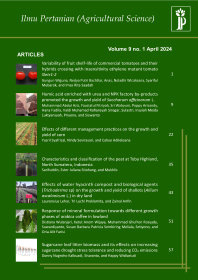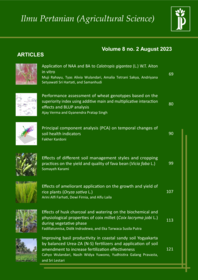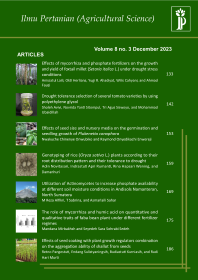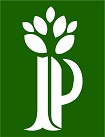Various Shallot Seed Treatments with Trichoderma to Increase Growth and Yield on Sandy Coastal
Stefany Darsan(1*), Endang Sulistyaningsih(2), Arif Wibowo(3)
(1) Department of Agronomy, Faculty of Agriculture, Universitas Gadjah Mada
(2) Department of Agronomy, Faculty of Agriculture, Universitas Gadjah Mada
(3) Department of Plant Protection, Faculty of Agriculture, Universitas Gadjah Mada
(*) Corresponding Author
Abstract
Keywords
Full Text:
PDFReferences
Anonymous. 2015. Productivity Shallot By Province, 2010-2014. Yogyakarta: BPS Provinsi D. I. Y.
Harman, G. E. 2000. Myths and Dogmas of Biocontrol. Plant Dis., 84: 377-393.
Harris, D., R. S. Tripathi and A. Joshi. 2000. On- Farm Priming to Improve Crop Establishment and Yield in Direct-Seeded Rice. Paper presented to the International Workshop on Dry-Seede Rice Technology, Bangkok, IRRI, 25-28 January.
Ilyas, S. 2006. Seed Treatments Using Matriconditioning to Improve Vegetable Seed Quality. Bul. Agron., 34: 124-132.
Landa, B. B., J. A. Navas-Cortes, R. M. Jimenez-Diaz. 2004. Integrated Management of Fusarium Wilt of Chickpea with Sowing Date, Host Resistance and Biological Control. Phytopathology, 94: 946-960.
Lanzotti, V. 2006. The Analysis of Onion and Garlic. J. Cromatogr, 1112 (1-2):3-22.
Merhi, F., J. Auge, F. Rendu and B. Bauvois. 2008. Allium Compounds, Dipropyl and Dimethyl Thiosulfinates as Antiproliferative and Differntiating Agents of Human Acute Myeloid Leukemia Cell Lines. Abstract Biologics. Dec, 2(4): 885-95.
Monte, E. 2001. Understanding Trichoderma:Between Biotechnology and Microbial Ecology. Int Microbiol., 4: 1-4.
Mastouri, F.; T. Bjo¨rkman and G.E. Harman. 2010. Seed Treatment with Trichoderma Harzianum Alleviates Biotic, Abiotic, and Physiological Stresses in Germinating Seeds and Seedlings. Phytopathology, 100: 1213–1221.
Naseby, D., J. Pascual and J. Lynch. 2000. Effect Of Biocontrol Strains Of Trichoderma On Plant Growth, Pythium Ultimum Populations, Soil Microbial Communities And Soil Enzyme Activities. Journal of Applied Microbiology, 88: 161–169.
Rajiman, 2014. Effect of Soil Improvement Materials In Beach Sand Land Against Soil Quality. Proceedings of the National Seminar on Suboptimal Land: 147-154.
Rajiman, Y., P. Yudono, E. Sulistyaningsih, and E. Hanudin. 2008. Effect of Soil Movement to Physical Properties of Soil and Shallot Yield on Bugel Kulon Progo District Sand Land. Agrin Journal, 12(1): 67-77.
Shoresh, M., G. E. Harman, and F. Mastouri. 2010. Induced Systemic Resistance and Plant Responses to Fungal Biocontrol Agents. Annu Rev Phytopathol., 48: 21–43.
Sulistyaningsih, E., K. Yamashita and Y. Tashiro. 2002. Haploid Induction From F1 Hybrids Between CMS Shallot whit Allium galanthum cytoplasmaand commo onion by unpollinated flower culture. Euphytica, 125: 139-144.
Sutariati, G. A. K., S. Leomo, and T. C Rakian, 2014. Performance of Growth and Results of shallot (Allium Ascalonicum L.) Bulbs In Various Sizes And Technology Leisa. Agriplus., 24(1): 12-19.
Sutariati, G. S. K. and A. Khaeruni 2013. Seed Biomatriconditioning Using Rhizobacteria for Growth Promotion and Increase the Yield of Sorghum (Sorghum bicolour (L.) Moench) on Marginal Soil. Agricultural Science Research Journals, 3(3): 85-92.
Article Metrics
Refbacks
- There are currently no refbacks.
Ilmu Pertanian (Agricultural Science) ISSN 0126-4214 (print), ISSN 2527-7162 (online) is published by Faculty of Agriculture Universitas Gadjah Mada collaboration with Perhimpunan Sarjana Pertanian Indonesia (PISPI) and licensed under a Creative Commons Attribution-ShareAlike 4.0 International License.













